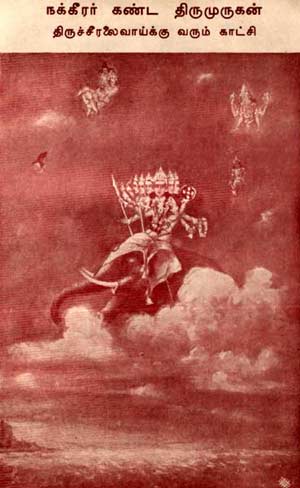
 |
| Nakkeerar says that Muruga comes to Tiruchendur "borne aloft on elephant, swiftly striding, irresistible as death, fleet as the risen wind" |
It was here that Saint Nakkeerar, the auhor of
Tiru Murugātru Padai, said:
 "All the ordeals that I face would melt away the moment I mention the sacred name of Vēlavan who resides at Senthil. The evil effects arising out of my karma would disappear the moment I utter the name of the Lord of Tiruchendur.”
"All the ordeals that I face would melt away the moment I mention the sacred name of Vēlavan who resides at Senthil. The evil effects arising out of my karma would disappear the moment I utter the name of the Lord of Tiruchendur.”
Arunagirinathar conveys the same idea in Kandar Alankaram:
"So long as you are beside me, so long as your six sacred faces and the twelve helping hands are there and so long the grace of your lotus feet adorned by thandai, your broad shoulders adorned by kadampa garland are there before me, how can the planetary movements  affect me?” (Nal en seyum, vinai thaan en seyum).
affect me?” (Nal en seyum, vinai thaan en seyum).
Perhaps, in keeping with the spirit of this hymn, the shrine of planetary gods (
navagraha sannadhi) that form part of any temple is not found here.
It was here at Tiruchendur that Arunagirinathar experienced the presence of Murugan which he expressed in his song
Thandayani Vendayum. Arunagirinathar has composed total of 84 songs on the Lord of Tiruchendur. The song which starts with the words
iyalisai says,
"Oh Lord of Tiruchendur, I seek your blessings to have a mind free from attachments or diversions so that I can keep chanting your powerful shadākshara mantra always.”
A familiar local tradition runs to the effect that about 1648 AD, a race of seafaring men, identified later as Dutch, descended upon Tiruchendur and carried away the idol Shanmukhar and Śiva Natarajar, thinking that they were made of gold. Their attempt at melting it proving futile, they tried to carry them away by sea. But the sea suddenly grew boisterous, and rocked the ship violently, so the sailors threw the idols into the sea.

Five years later in 1653 AD, Vadamalayappa Pillayaan, administrator of Tirunelveli District, had a dream in which Murugan appeared and gave directions to locate the idol. Acting to the advice conveyed to him by the God, he put out to sea and following the instructions that the idol was to be found at the spot whereon a lime fruit would be found floating, and the place marked by the circling overhead of a kite, the bird of Vishnu. Vadamalaiappa Pillaiyyan recovered the original idol and reinstalled it in the temple.

Above all, Tiruchendur acquires importance because it was here Lord Murugan fulfilled the aim for which he manifested on earth. It was here Murugan used the powerful weapon of Vēl given by mother Parvati to conquer Soorasamharam, who took the form of a sinister mango tree to mislead Murugan. When Murugan hurled his Vēl, it pierced the tree and split it into two parts.
Murugan’s Vēl did not target Soorapadman as a human being, because there is divinity in every individual. Rather, Murugan’s Vēl targeted the ego embodied in Soorapadman. The soul of Sooran which attained its natural state of divinity then expressed its reverence apologised for being ego-centric and requested Murugan to accept him as His servant. Murugan then accepted him, converted one half of the split tree as his mount the peacock and the other half as his ensign the rooster.

Soorapadman was only a symbol; the real danger was the ego which he represented. The war Murugan waged at Tiruchendur was not a war against any individual. It was the war waged by Murugan, the symbol of love, against Soorapadman, the symbol of hatred. It was a war against the real enemy, hiding within, in the form of ignorance, anger and ego.
Though Murugan destroyed the enemy within Soorapadman, this enemy continues to manifest in different forms. Therefore, the war witnessed at Tiruchendur was only a beginning. We need to wage many more battles to drive out the enemies within and realize the presence of Murugan in our heart.
The more powerful the enemy, the greater the varieties of weapons we use. When the inner enemy is very powerful we need very powerful weapons also. What a better weapon we can have than the Vēl wielded by Murugan. Let us worship the Vēl and pray for being blessed with confidence, rectitude and vision.
Even a world war may last for few years but the inner war waged against ignorance, desires and ego should go on. So long we have the blessings of Murugan this war will end soon and we will attain the high state of happiness and peace.

Even before the advent of Kanda Sasti, Tiruchendur starts wearing a festive look. The devotees start arriving to experience the grace of Murugan. In 2016, the Kanda Sasti celebrations start on 31
st October and culminate on 7
th November.
During this period the forms of worship include anointment (abhishekam), special decoration (alankāram), offering of light (
deepa arādana) and processions in a golden chariot followed by pundits reciting
Vēl Vakuppu, Veera Val Vakuppu, etc. On the sixth day, Soorasamharam is enacted on the seashore watched by lakhs of devotees and on seventh day the celestial wedding of Murugan is conducted in splendour and glory.

The war with Soorapadman is symbolically over but the war against the evil forces like ego, pride, anger and intolerance which Soorapadman represented continues. Kanda Sasti is an occasion when the devotee should find out whether a miniature Soorapadman is present within. It is an occasion when he should seek the grace of Senthil Vēlavan and attain victory over the enemy within.
